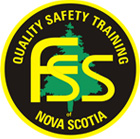Power Lines
Hazards Identified
Electrocution, burns, flashes, fire
Hazard-Specific Personal Protective Equipment
Hazard-Specific Training
Orientation to this Safe Work Practice
Safe Work Practice
- Plan the work two weeks in advance if possible.
- Before starting work, undertake a hazard assessment, including an assessment of whether or not a spotter is required.
- Call before you work under a power line to get the voltage of the line and a clearance report.
- Call before you dig, to get the location of underground lines.
NSPI 1-800-428-6230 (in Sydney 564-5457), MTT 811
- If there is any possibility of encroaching on the safe distances from power lines noted below, plan to have a spotter. Note Section 57 (1) of the Occupational Safety General Regulations requires:
“An employer shall designate one or more competent persons as a signaller to direct the safe movement of a load, hoist, industrial lift truck or powered mobile equipment where the operator of that hoist, industrial lift truck or powered mobile equipment…”
“(d) is not able to see clearly where the hoist or its load may encroach the minimum distance specified in Section 126 or a hoist is positioned closer than the length of its boom to an overhead energized power line or power line equipment…”
- Check clearances each time you work near power lines.
- If the voltage of the overhead energized power line is unknown, do not approach within 6 metres (20 feet).
- If the voltage of the overhead energized power line has been determined, approach must be limited to the following distances:
750 – 69,000 v – 3 m (10 feet)
69, 000 – 138,000 v – 5 m (17 feet)
greater than 138,000 v – 6 m (20 feet)
Power Lines (continued)
- Voltage less than 750 v, work at an adequate distance to ensure safety. This distance may be determined by contacting the power utility, which may be able to assist by shielding or easing (moving lines or de-energizing them.
- Ensure the boom/dump body of the truck is down before leaving the site.
- Ensure maximum height of load, including knuckle boom, is under legal height limit.
- If contact is made with a line call the utility responsible.
Regulations, Standards and References
Occupational Safety General Regulations, section 126
